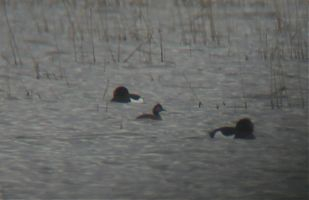Birder’s diary - 24.04
Birder Margus Ots, Linnuvaatleja.ee
Translation: Liis
Black-necked grebe Mustkael–pütt
In the morning the weather in Tartu was steadily rainy and at last I got to sleep a little longer. But I had still planned to go out, the target was the best bird spots of Pärnumaa. On the way I made the first stop at Rämsi polder where quite many waterfowl were visible in the flooded areas. At once on getting out of the car, I could note the first species – 3 wood sandpipers were flying around calling loudly. A few moments later a hen harrier scared a large duck flock into flight and following the birds in binoculars I suddenly noticed above my head among the wigeons a largish grey wader with black underparts and wing-pits. There were no other possibilities, the bird was a grey plover! But, what was the creature doing here now? Generally migrating grey plovers are seen here in May and mainly on the western coast, inland it is a rare visitor. But at the same time, some searching in the e-Biodiversity data base showed that last year three grey plovers were seen on nearly the same date at the Ardla polder near Tartu. So there is nothing very extraordinary in this find.
I also went to the Navesti polder again. The flood water is sinking fast here, but as before there are still many waterfowl in the area. The most exciting bird here today was the Caspian tern (3 birds in overflight), that is not often seen inland. I didn’t find any new species at the Navesti polder, but in the nearby Venevere village a house martin was circling above Navesti river among the barn swallows. They too begin to arrive by and by. Sand martins take their time, they arrive here only in May.
In Pärnumaa I first headed for the Audru polder and tried to inspect the local “duck soup“ by telescope. In a couple of hours I only managed to survey the eastern part of the polder where thousands of ducks stay on the extensive flooded area. The most numerous today were wigeons (1100), teals (850), tufted ducks (700), northern pintails (460), goldeneyes(210) and shovelers (120), in addition 2500 geese (mainly greater white-fronted geese) and 500 barnacle geese. Here too migrating Caspian ternscould be seen – 5 birds flew past high up. As new species for my year list I got from the Audru polder the spotted redshank, but the day did not pass without even better rarities either. I had already checked the duck flock by telescope several times and was just going to move on when I noticed far away on the other side of the flooded area a little grebe diving. When the bird surfaced again all was clear – the bird was a black-necked grebe! It is a real rarity that according to the Bird rarities committee data have been seen in Estonia only some twenty times. In Pärnumaa this species has never been seen before. During recent years observations of black-necked grebes have become more frequent in Estonia, in 2011 there were 5 finds. Beginning from the early 1990s the species has been seen altogether 12 times here and as it happens, on 8 of these occasions I have seen the bird myself.

Another foggy photo – black-necked grebe at Audru polder 24.04.2012.
Since the bird was far away and approaching it did not succeed I tried to get a photo somehow through the telescope with an ordinary lens. In the hazy photo luckily the most important features (the shape of the head and the pattern) were visible and for the Bird rarities committee at least some evidence exists. Fortunately I had time to show the bird to a couple of local birders. Hopefully the grebe will stay in place and I will get a better photo tomorrow.
But today had one more surprise in store. In the evening I reached Kabli bird station. Since a moderate east wind was to blow next day, a proper passerine migration might be seen. As I was preparing for the next day in the bird station Juho Könönen who is counting migrants here at present asked, when do great snipes usually arrive in Estonia? At first I didn’t understand the Finnish species name at once but when Juho said that just now one displays outside the station I jumped out. And so it was, a great snipe “rattling” at full force in the shore meadow some twenty meters away. This bird I hadn’t hoped to find here. Probably it had just landed from migration, decided to have a little display and then to move on. An hour later the bird was not to be heard any more.
With today’s interesting trip 6 new species were added to my 2012 species list, altogether they are 188 now.








